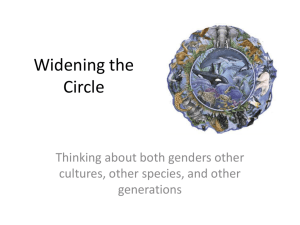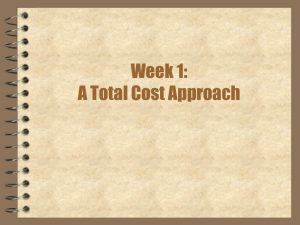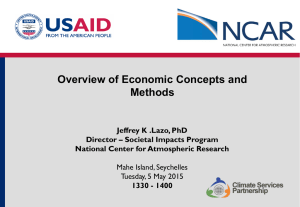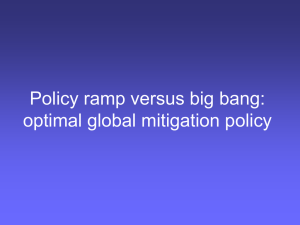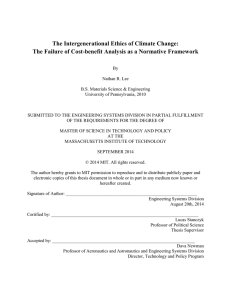Craig Douglas Econ 4999 “Reverse Engineering” a Long Term Discount Rate
advertisement
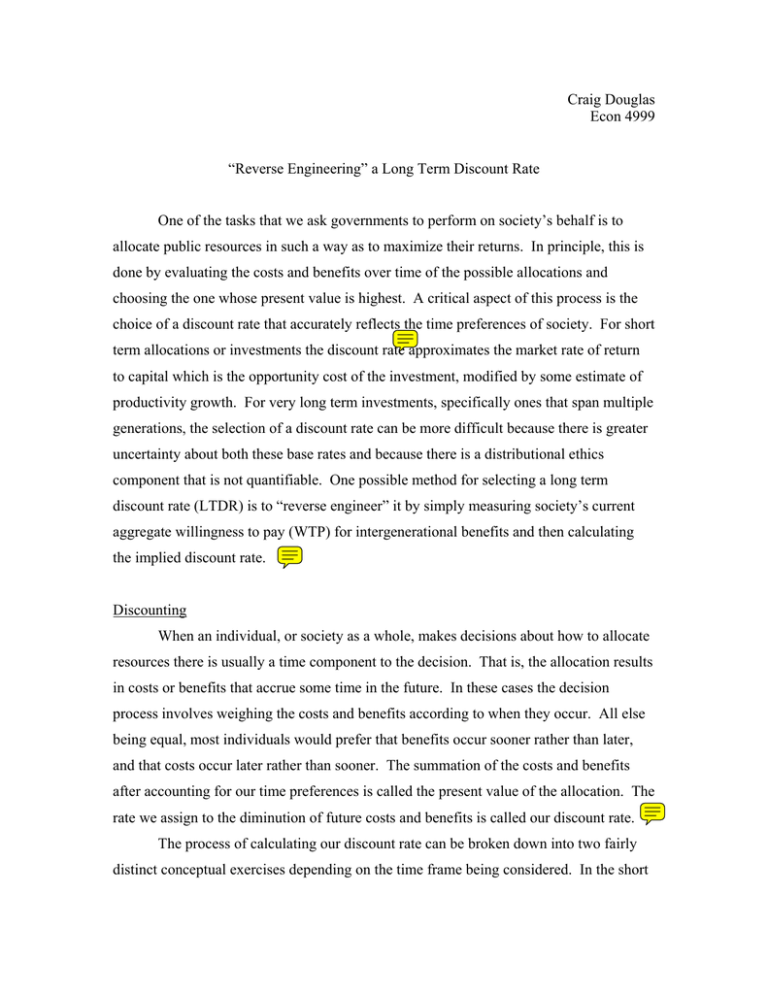
Craig Douglas Econ 4999 “Reverse Engineering” a Long Term Discount Rate One of the tasks that we ask governments to perform on society’s behalf is to allocate public resources in such a way as to maximize their returns. In principle, this is done by evaluating the costs and benefits over time of the possible allocations and choosing the one whose present value is highest. A critical aspect of this process is the choice of a discount rate that accurately reflects the time preferences of society. For short term allocations or investments the discount rate approximates the market rate of return to capital which is the opportunity cost of the investment, modified by some estimate of productivity growth. For very long term investments, specifically ones that span multiple generations, the selection of a discount rate can be more difficult because there is greater uncertainty about both these base rates and because there is a distributional ethics component that is not quantifiable. One possible method for selecting a long term discount rate (LTDR) is to “reverse engineer” it by simply measuring society’s current aggregate willingness to pay (WTP) for intergenerational benefits and then calculating the implied discount rate. Discounting When an individual, or society as a whole, makes decisions about how to allocate resources there is usually a time component to the decision. That is, the allocation results in costs or benefits that accrue some time in the future. In these cases the decision process involves weighing the costs and benefits according to when they occur. All else being equal, most individuals would prefer that benefits occur sooner rather than later, and that costs occur later rather than sooner. The summation of the costs and benefits after accounting for our time preferences is called the present value of the allocation. The rate we assign to the diminution of future costs and benefits is called our discount rate. The process of calculating our discount rate can be broken down into two fairly distinct conceptual exercises depending on the time frame being considered. In the short term, realization of costs and benefits comes soon enough that our primary guide in discounting them is the evaluation of the private trade-offs we face when foregoing opportunities across time. In addition to the returns we receive from alternative allocations, these trade-offs involve how risk averse we are and our marginal utility function. As the time frame expands, and particularly when it spans multiple generations, evaluation of private trade-offs becomes problematic because some or all of the benefits our choices create are postponed beyond our ability to personally enjoy them. In this long term situation the calculus of private time preferences yields a present value of zero for benefits that are not enjoyed by the decision makers. Some of the decisions society faces, however, clearly fall into the long term category. For example, we must decide the merits of reducing green house gas emissions, continuing to produce nuclear waste, and saving endangered species habitat, all of which produce costs or benefits that extend far into the future. The implication of personal discounting, that benefits not personally received have no present value, is counter-intuitive. Most individuals would be willing to incur some cost to generate a specific future benefit even if they could not share in it. So where does that present value derive from and at what rate must they be discounting? An LTDR that is purely intergenerational in scope measures society’s sense of distributional equity across generations. This social sense of fairness is different for each of us in the same way that our private preferences differ and derives from our belief systems developed over time. Assuming that an individual’s private valuation of long term benefits is zero, any positive valuation of long term benefits is a reflection of that individual’s social discount rate. By aggregating our collective present valuations of specific long term investments, such as green house gas mitigation, we could work backwards to construct a LTDR that estimates a composite inter-generational welfare function for society. Method of Aggregation The aggregation could be accomplished through a contingent valuation survey. A random sample of the general population would be selected and asked that they specify, in essence, the amount of consumption they are willing to forgo so that a particular long term public investment could be made. Each participant would receive as complete a description as possible of the costs and benefits involved with the project, the time at which they would occur, where they would occur, and to whom. Historical rates of productivity growth and returns on capital would be provided. The many risks that would be present would also be communicated. These would include the risk that intervening generations would fail to continue the required rate of investment, the risk that we will mispredict the consumption preferences of future generations, and the great uncertainty involved in forecasting any type of benefits and costs so far into the future. With this background, participants would be asked to respond positively or negatively to estimates of their personal costs if the investment were to be made. The results of the survey would be used in a linear regression to estimate a total WTP for the general population, and from there a LTDR could be calculated using an inverse of the present value function shown in equation (1). PV = B1/(1+r)1 + B2/(1+r)2 +…+ Bt/(1+r)t (1) where Bt is the net benefit accruing in time period t and r is the discount rate. An inverse of this function can be estimated, for example, with equation (2), LTDR = r = (Bt/WTP)1/t –1 (2) where B is the time-weighted mean benefit, t is the year in which the weighted mean benefit occurs, and WTP is the current expression of present value. It is likely that individuals will have a different discounting function, one that may not be smoothly declining, but equation (2) will accurately describe an effective rate as expressed through aggregation. Independent Variables Included in the regression would be independent variables that would assist in understanding how population characteristics influence responses. Some would reveal private valuation components. Others might show biases in their WTP. Of these, the most important would be: Education. The complexity of the information that would have to be consumed prior to responding to the survey would mean that the responses of poorly educated participants may exhibit information bias due to their failure to understand the information provided. Family size. Parents will have a private interest in benefits that accrue after their death because their descendents give them a stake in future generations. The well-being that parents derive from the well-being of their children is, in turn, somewhat dependent on the well-being that their children derive from their children, and so on through multiple generations. Religion. This could have predictive value because some religious doctrines have implied suggestions for treating future generations. For example, religions that include the concept of reincarnation may be suggesting that we treat future generations with some notion of equality since we may end up being them. There is a temporal version of Rawl’s “veil of ignorance” in this doctrine that could lead one to want to equalize utility across generations. Although there are plenty of Christian references to charity, since they officially find their rewards in the afterlife, they may be less worried about future well-being. Taoists take a laissez-faire approach to most things in life and so may want to avoid interfering with future generations at all. Location. Because some long term investments have a spatial aspect - global warming, for example, would have a bigger impact on coastal areas - location of the participant should be included. Income. This would determine the participants budget constraints. Accuracy of the Method An apparent flaw in this scheme is that the estimate of the LTDR is completely dependent on the accuracy of the survey’s prediction of future benefits. But it would not matter if benefits are inaccurately estimated because only the relationship between the participant’s perception of benefits and their WTP for them matters. On the other hand, an accurate understanding of other aspects, such as risks and alternate opportunities, would have a significant impact on the calculated LTDR. A benefit of contingent valuation is that it can fully capture the intangible values that ethical consideration represents. Of concern, however, would be the other distortions that are inherent in any contingent valuation such as hypothetical bias, strategic bias, and framing bias. Political Mandate An advantage of having the current generation actively participate in the determination of the LTDR is the political mandate that it creates. We are asking participants to weigh the current value, via their WTP, of some possible future benefit. This is very different from the process of assessing the present value of a past benefit or cost. When some benefit or cost has already occurred the present value or damages can be calculated using various methods and property rights can be used to enforce a payoff – it becomes a legal issue. There are no property laws covering future benefits or damages that might occur. There must be certainty of occurrence before courts can assign liability and compensation. Without that certainty a political mandate must be obtained. Conclusion LTDRs estimated by contingent valuation surveys may have a short lifetime. The estimate would likely change with changing economic conditions and demographics. It is just a snapshot that would have to be repeated periodically. Eventually, with surveys completed for a variety of investment types, and under a variety of economic and social circumstances, a more complete model of how society discounts long term investments might emerge that could be used directly in the policy decision process without the need for frequent surveys. Economists have proposed many different approaches to long term discounting, many of which have strong supporting arguments. Unfortunately, it is impossible to completely reconcile them due to the intangibles previously discussed. The alternative approach suggested here could produce the consensus needed for governments to make critical long term investments. Bibliography Cline, William R. “Discounting for the Very Long Term.” In Discounting and Intergenerational Equity, ed. Portney and Weyant, 99-101. Washington: RFF Press, 1999 Kopp, Raymond J. and Portney, Paul R. “Mock Referenda for Intergenerational Decisionmaking.” In Discounting and Intergenerational Equity, ed. Portney and Weyant, 99-101. Washington: RFF Press, 1999 Rothenberg, Jerome. “Intergenerational Ethics, Efficiency, and Commitment.” In Discounting and Intergenerational Equity, ed. Portney and Weyant, 99-101. Washington: RFF Press, 1999 Schelling, Thomas C. “Intergenerational Discounting.” In Discounting and Intergenerational Equity, ed. Portney and Weyant, 99-101. Washington: RFF Press, 1999 Tietenberg, Tom. Environmental and Natural Resource Economics. New York: Addison Wesley, 2003

